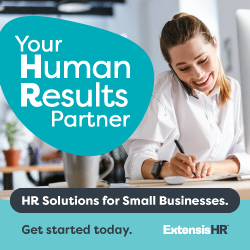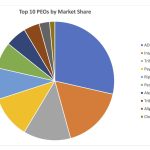In today’s competitive business landscape, executives are constantly seeking ways to streamline operations, reduce costs, and drive growth. Professional Employer Organizations (PEOs) have emerged as a powerful solution for many businesses, offering comprehensive HR, payroll, and benefits services. But how can business leaders make informed decisions about PEOs and leverage them effectively? The answer lies in harnessing industry data and fostering strategic partnerships.
The Power of PEO Industry Data
Recent discussions among industry leaders have highlighted the critical role that data plays in shaping PEO strategies and decision-making processes. Let’s dive deeper into key insights and their implications for business executives.
1. Market Penetration Insights
Understanding PEO adoption rates across different states can help businesses identify untapped markets and growth opportunities. According to recent data from the National Association of Professional Employer Organizations (NAPEO):
- Pennsylvania and Ohio have the lowest PEO penetration rates
- Florida and Georgia lead in PEO adoption

In 2019, Vensure Employer Services, a leading PEO, identified Ohio as an underserved market based on this data. They launched a targeted marketing campaign and established strategic partnerships with local chambers of commerce. Within 18 months, they reported a 35% increase in Ohio-based clients, demonstrating the power of data-driven market entry strategies.
2. Industry-Specific Trends
PEO usage varies significantly across industries. By analyzing this data, businesses can benchmark their HR practices against industry norms and identify areas for improvement.
The construction industry has seen a significant uptick in PEO adoption. According to a 2022 NAPEO report, PEO usage in the construction sector increased by 23% between 2018 and 2021. This trend is attributed to the industry’s complex compliance requirements and seasonal workforce fluctuations.
3. ROI and Growth Metrics
According to NAPEO, the average ROI of working with a PEO is 27.2%. Furthermore, companies partnering with PEOs are significantly less likely to go out of business.
A study conducted by McBassi & Company in 2019 found that small businesses that work with PEOs are 50% less likely to go out of business from one year to the next, compared to similar companies that do not use PEOs. This statistic underscores the value of PEOs in enhancing business stability and longevity.
Leveraging Data for Strategic Decision-Making
As a business executive, how can you use this data to your advantage? Let’s explore some strategies with real-world applications.
1. Targeted Expansion
If you are considering expanding your business, look at PEO penetration rates in different states. Lower penetration might indicate an opportunity to gain a competitive edge by adopting PEO services in those markets.
In 2020, TechInnovate, a growing software company based in California, used PEO penetration data to inform their expansion strategy. They identified North Carolina as a state with relatively low PEO adoption but a burgeoning tech scene. By partnering with a PEO familiar with the local market, TechInnovate was able to quickly establish a presence in Research Triangle Park, tapping into the local talent pool while minimizing HR and compliance risks associated with multi-state operations. The additional benefits and HR services attracted and retained new team members.
2. Industry Benchmarking
Compare your HR costs and practices against industry averages. This can help identify areas where a PEO could potentially offer significant value.
Midwest Manufacturing, a medium-sized manufacturing company, conducted an industry benchmarking exercise in 2021. They discovered that their HR costs were 22% higher than the industry average, and their employee turnover rate was 15% above the norm. After partnering with a PEO specializing in the manufacturing sector, they were able to reduce HR costs by 18% within the first year and bring their turnover rate in line with industry standards through improved benefits and HR practices.
3. Risk Mitigation
Use data on business survival rates to make a case for PEO adoption as a risk mitigation strategy, especially for growing businesses.
There is a trend within venture capital firms recommending PEO services to their portfolio companies based on survival rate data. Consider that of the 50 startups in a portfolio that adopted PEOs, 45 were still operational after three years, compared to only 30 out of 50 that did not use PEOs. This 30% increase in survival rate has since become a key part of venture capital support strategy for their investments.
Building Strategic Partnerships
Data is just one piece of the puzzle. To truly maximize the benefits of working with a PEO, consider these partnership strategies:
1. Engage with Industry Associations
As one industry expert noted, “If you’re good with the executive director of the Medical Association for your region, you can be in the door of large doctor practices in no time.” Build relationships with trade associations relevant to your industry.
HealthTech Solutions, a PEO specializing in healthcare, developed a partnership with the American Medical Association (AMA) in 2019. They offered exclusive webinars on HR best practices for medical practices to AMA members. This partnership resulted in a 40% increase in leads from the healthcare sector and established HealthTech Solutions as a thought leader in the industry.
2. Leverage Niche Communities
Platforms like Reddit host numerous industry-specific subgroups. Engaging authentically in these communities can position your business as a thought leader and generate warm leads.
HR Innovations, a boutique PEO, assigned a dedicated team member to engage in the r/small business and r/startups subreddits in 2020. By providing valuable advice and insights without overt self-promotion, they built a reputation as a trusted resource and authentic community member.
Emerging Trends in PEO Data and Partnerships
As the business landscape continues to evolve, new trends are emerging in the PEO industry. Staying ahead of these trends can provide a significant competitive advantage.
1. AI and Machine Learning in PEO Services
PEOs are increasingly leveraging AI and machine learning to enhance their services, from predictive analytics for workforce planning to AI-driven chatbots for employee self-service.
PEOs are implementing an AI-driven performance management system. By analyzing patterns in employee data, the system provides predictive insights on potential turnover risks and suggests personalized retention strategies. Clients using this system reported a 20% reduction in unwanted turnover within the first six months.
2. Focus on Employee Wellbeing
Post-pandemic, there is an increased emphasis on employee wellbeing programs. PEOs are expanding their offerings to include mental health support, financial wellness programs, and work-life balance initiatives.
PEOs have launched comprehensive employee wellbeing programs, including virtual mental health counseling, financial planning assistance, and flexible work arrangements. Clients who adopted this program saw a 30% increase in employee satisfaction scores and a 25% reduction in absenteeism.
3. Remote Work Support
With the rise of remote and hybrid work models, PEOs are developing specialized services to support distributed teams.
PEO introduced Remote Work Packages, offering services like virtual team building, home office stipends, and training for remote managers. Clients who adopted this package reported a 40% increase in remote employee productivity and a 50% improvement in remote team collaboration scores.
Overcoming Challenges in PEO Adoption
While the benefits of PEOs are clear, some businesses face challenges in adoption. Here are some common hurdles and strategies to overcome them:
1. Resistance to Change
Many businesses, especially those with established HR departments, may resist the shift to a PEO model.
Implement a phased approach to PEO adoption, starting with specific HR functions. Communicate the benefits clearly to all stakeholders and involve key team members in the decision-making process.
Address the initial resistance from HR teams. Consider establishing a short-term transition plan, gradually shifting responsibilities to the PEO while retraining HR staff for more strategic roles. This approach resulted in a smooth transition with most HR staff retained in new, higher-value positions.
2. Concerns About Loss of Control
Some executives worry about losing control over HR functions when partnering with a PEO.
Choose a PEO that offers customizable services and maintains open lines of communication. Establish clear KPIs and regular review processes to ensure alignment with your business goals.
Consider a provider that offers à la carte services, allowing your organization to maintain control of culture-critical functions while outsourcing administrative tasks. This balanced approach will lead to a reduction in HR administrative time without compromising their cultural values.
3. Integration with Existing Systems
Integrating PEO services with existing business systems can be technically challenging.
Prioritize PEOs with robust integration capabilities and experience with your industry-specific software. Plan for a detailed discovery phase to identify potential integration issues early.
Partnering with a PEO with experience in your business sector and should allow for API-based integration. Use a gradual integration process, and you should achieve seamless data flow between systems, reducing manual data entry and improving overall operational efficiency.
The Future of PEOs: Trends to Watch
As we look to the future, several trends are shaping the PEO industry:
1. Increased Specialization: PEOs are likely to become more specialized, focusing on specific industries or business sizes to provide more tailored services.
2. Technology Integration: Expect to see more PEOs offering advanced tech solutions, including AI-driven analytics, blockchain for secure record-keeping, and IoT for workforce management.
3. Global Expansion: As businesses become increasingly global, PEOs will expand their international capabilities to support worldwide workforces.
4. Focus on Compliance: With ever-changing regulations, PEOs will likely double down on compliance services, becoming indispensable partners in navigating complex legal landscapes.
5. Emphasis on Employee Experience: Future PEOs will likely offer more comprehensive employee experience platforms, integrating everything from onboarding to retirement planning in user-friendly interfaces. Excited About the 2024 PEO Industry Outlook
The Bottom Line
In an era where data drives decisions and partnerships fuel growth, business executives must take a proactive approach to leverage PEO services. By harnessing industry data and fostering strategic partnerships, you can make informed decisions that streamline operations, reduce costs, and ultimately drive sustainable business growth.
Remember, the goal is not just to adopt a PEO — it is to integrate these services strategically into your broader business operations and growth plans. With the right data, partnerships, and strategy, you will be well-equipped to navigate the complexities of modern business operations and stay ahead of the curve. Good Guide to Analyze Your Workforce Management Costs
By thoughtfully considering these questions and leveraging the insights provided, you will be well-positioned to make strategic decisions that propel your business forward in today’s competitive landscape.
Contact one of our affiliates or email Mark J. Burger, CPA, by using the Contact Us link in the top navigation bar.

1. How can PEO data inform your expansion or optimization strategies?
PEO data can play a crucial role in informing expansion or optimization strategies by providing insights into market penetration rates, industry trends, and the financial impact of PEO adoption. For example, understanding which states or regions have low PEO penetration can help businesses identify untapped markets where there is less competition and a greater opportunity for growth. Analyzing industry-specific data on PEO usage can also allow businesses to benchmark their human resources practices against industry norms and identify areas for improvement. Moreover, data on the return on investment (ROI) and business survival rates for companies using PEOs can be valuable for businesses looking to enhance stability, reduce costs, and mitigate risks. By leveraging these insights, business executives can make informed decisions about where to expand, how to optimize their operations, and which markets offer the best opportunities for growth.
2. What strategic partnerships could amplify your business growth?
Strategic partnerships with key organizations, such as industry associations, local chambers of commerce, or niche communities, can significantly amplify business growth by expanding a company’s network, enhancing credibility, and generating qualified leads. For example, collaborating with industry associations can provide direct access to a target audience and establish the business as a thought leader in that sector, as seen in the case where HealthTech Solutions partnered with the American Medical Association to gain visibility among medical professionals. Similarly, engaging authentically in niche communities, like industry-specific subreddits, can help businesses build trust and credibility, positioning them as experts and attracting potential clients. Such partnerships can create synergies that enhance market presence, foster trust, and open new avenues for growth by tapping into established networks and communities.
3. How might emerging PEO trends align with your long-term business goals?
Emerging PEO trends, such as the integration of artificial intelligence (AI) and machine learning, a heightened focus on employee wellbeing, and the development of specialized services for remote and hybrid workforces, can align with long-term business goals by addressing critical needs in workforce management, employee engagement, and operational efficiency. For example, businesses aiming to reduce turnover and enhance employee satisfaction could benefit from PEOs that offer AI-driven analytics for workforce planning and personalized retention strategies. Similarly, companies with a remote or distributed workforce might find alignment with PEOs developing remote work support packages, such as virtual team-building activities and home office stipends. By aligning with these trends, businesses can improve their internal processes, adapt to changing workforce expectations, and maintain a competitive edge in a dynamic market.





